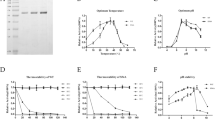Abstract
A putative glutamine synthetase (GS) was detected in a psychrophilic bacterium, Cryobacterium soli GCJ02. For gaining greater insight into its functioning, the gene was cloned and expressed in a heterologous host, Escherichia coli. The monomer enzyme with a molecular weight of 53.03 kDa was expressed primarily in cytosolic compartment. The enzyme activity was detected using glutamate and ATP. The optimum conditions of its biosynthesis were observed to be 60 °C and pH value 7.5. Its thermostability was relatively high with a half-life of 50 min at 40 °C. GS activity was enhanced in the presence of metal ions such as Mg2+ and Mn2+, whereas Fe2+, Cu2+ and Ca2+ proved inhibitory. The consensus pattern [EXE]-D-KP-[XGXGXH] in the GS lies between residues 132 and 272. The catalytic active sites consisting of EAE and NGSGMH were verified by site-directed mutagenesis. Based on the analysis of the consensus pattern, the GS/glutamate synthase cycle of C. soli GCJ02 is expected to contribute to the GS synthesic activity.





Similar content being viewed by others
References
Fisher SH (1999) Regulation of nitrogen metabolism in Bacillus subtilis: vive la difference! Mol Microbiol 32:223–232. https://doi.org/10.1046/j.1365-2958.1999.01333.x
Luque-Almagro VM, Gates AJ, Moreno-Vivián C, Ferguson SJ, Richardson DJ, Roldán MD (2011) Bacterial nitrate assimilation: gene distribution and regulation. Microbiol Rev 59:604–622. https://doi.org/10.1042/BST20110688
Brown CM, Mcdonald-Brown DS, Meers JL (1974) Physiological aspects of microbial inorganic nitrogen metabolism. Adv Microbiol Physiol 11:1–52. https://doi.org/10.1016/S0065-2911(08)60268-4
Erfle JD, Sauer FS, Mahadevan S (1977) Effect of ammonia concentration on activity of enzymes of ammonia assimilation and on synthesis of amino acids by mixed rumen bacteria in continuous culture. J Dairy Sci 60:1064–1072. https://doi.org/10.3168/jds.S0022-0302(77)83989-1
Eisenberg D, Gill HS, Pfluegl GM, Rotstein SH (2000) Structure function relationships of glutamine synthetases. Biochim Biophys Acta 1477:122–145. https://doi.org/10.1016/s0167-4838(99)00270-8
Hill RT, Parker JR, Goodman HJK, Jones DT, Woods DR (1989) Molecular analysis of a novel glutamine synthetase of anaerobe Bacteroides fragilis. J Gen Microbiol 135:3271–3279. https://doi.org/10.1099/00221287-135-12-3271
Amaya KR, Kocherginskaya SA, Mackie RI, Cann IK (2005) Biochemical and mutational analysis of glutamine synthetase type III from the rumen anaerobe Ruminococcus albus 8. J Bacteriol 187:7481–7491. https://doi.org/10.1128/JB.187.21.7481-7491.2005
Crespo JL, Garcia-Dominguez M, Florencio FJ (1998) Nitrogen control of the glnN gene that codes for GS type III, the only glutamine synthetase in the cyanobacterium Pseudanabaena sp. PCC 6903. Mol Microbiol 30:1101–1112. https://doi.org/10.1046/j.1365-2958.1998.01143.x
Goodman HJ, Woods DR (1993) Cloning and nucleotide sequence of the Butyrivibrio fibrisolvens gene encoding a type III glutamine synthetase. J Gen Microbiol 139:1487–1493. https://doi.org/10.1099/00221287-139-7-1487
Avisar N, Shiftan L, BenDror I, Havazelet N, Vardimon L (1999) A silencer element in the regulatory region of glutamine synthetase controls cell type-specific repression of gene. J Biol Chem 274:11399–11407. https://doi.org/10.1074/jbc.274.16.11399
Caizzi R, Bozzetti MP, Caggese C, Ritossa F (1990) Homologous nuclear genes encode cytoplasmic and mitochondrial glutamine synthetase in Drosophila melanogaster. J Mol Biol 212:17–26. https://doi.org/10.1016/0022-2836(90)90301-2
Christa L, Simon MT, Flinois JP, Gebhardt R, Brechot C, Laserre C (1994) Overexpression of glutamine synthetase in human primary liver cancer. Gastroenterology 106:1312–1320. https://doi.org/10.1016/0016-5085(94)90024-8
Lai XF, Gao H, Kong J, Wang QY, Wang WJ, Meng XH (2011) Cloning and characterization of the glutamine synthetase gene from Chinese shrimp Fenneropenaeus chinensis. Aquacult Int 19:873–889. https://doi.org/10.1007/s10499-010-9407-7
Kichey T, Le Gouis J, Sangwan B, Hirel B, Dubois F (2005) Changes in the cellular and subcellular localization of glutamine synthetase and glutamate dehydrogenase during flag leaf senescence in wheat (Triticum aestivum L.). Pl Cell Physiol 46:964–974. https://doi.org/10.1093/pcp/pci105
Gong CJ, Lai QL, Cai HF, Jiang YM, Liao H, Liu YF, Xue DS (2019) Cryobacterium soli sp. nov., isolated from forest soil. Int J Syst Evol Microbiol. https://doi.org/10.1099/ijsem.0.003820
Xue DS, Zhang SY, Wang CJ, Gong CJ (2019) The complete genome sequence and annotation of a psychrophilic Cryobacterium species GCJ02 isolated from cryomorphic soil of a virgin forest. Appl Environ Biotechnol 4:44–48. https://doi.org/10.26789/AEB.2019.01.006
Imran M, Sun X, Hussain S, Ali U, Rana MS, Rasul F, Saleem MH, Moussa MG, Bhantana P, Afzal J, Elyamine AM, Hu CX (2019) Molybdenum-induced effects on nitrogen metabolism enzymes and elemental profile of winter wheat (Triticum aestivum L.) under different nitrogen sources. Int J Mol Sci 20:3009. https://doi.org/10.3390/ijms20123009
Zhao W, Yang J, Tian YS, Fu XY, Zhu B, Xue Y, Gao JJ, Han HJ, Peng RH, Yao QH (2014) Expression, purification, and characterization of recombinant mangrove glutamine synthetase. Mol Biol Rep 41:7575–7583. https://doi.org/10.1007/s11033-014-3649-9
Ishiyama K, Inoue E, Watanabe Takahashi A, Obara M, Yamaya T, Takahashi H (2004) Kinetic properties and ammonium-dependent regulation of cytosolic isoenzymes of glutamine synthetase in Arabidopsis. J Biol Chem 279:16598–16605. https://doi.org/10.1074/jbc.M313710200
Wellner VP, Meister A (1966) Binding of adenosine triphosphate and adenosine diphosphate by glutamine synthetase. Biochemistry 5:872–879. https://doi.org/10.1021/bi00867a010
Kim JN, Cann IKO, Mackie RI (2011) Purification, characterization, and expression of multiple glutamine synthetases from Prevotella ruminicola 23. J Bacteriol 194:176–184. https://doi.org/10.1128/JB.05916-11
Reitzer L (2003) Nitrogen assimilation and global regulation in Escherichia coli. Annu Rev Microbiol 57:155–176. https://doi.org/10.1146/annurev.micro.57.030502.090820
Rana NK, Mohanpuria P, Yadav SK (2008) Expression of tea cytosolic glutamine synthetase is tissue specific and induced by cadmium and salt stress. Biol Plant 52:361–364. https://doi.org/10.1007/s10535-008-0075-7
Acknowledgements
This work was supported by the Foundation of Hubei Provincial Department of Education (B2018040) and Research Fund for the Doctoral Program of Hubei University of Technology (No: BSQD14018).
Author information
Authors and Affiliations
Corresponding author
Ethics declarations
Conflict of interest
The authors declare no conflict of interest.
Additional information
Publisher's Note
Springer Nature remains neutral with regard to jurisdictional claims in published maps and institutional affiliations.
Rights and permissions
About this article
Cite this article
Gong, C., You, X., Zhang, S. et al. Functional Analysis of a Glutamine Biosynthesis Protein from a Psychrotrophic Bacterium, Cryobacterium soli GCJ02. Indian J Microbiol 60, 153–159 (2020). https://doi.org/10.1007/s12088-020-00858-7
Received:
Accepted:
Published:
Issue Date:
DOI: https://doi.org/10.1007/s12088-020-00858-7




